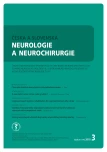Muscle biopsy in 10 key points
Authors:
J. Zámečník
Authors place of work:
Ústav patologie a molekulární medicíny, 2. LF UK a FN Motol, Praha
Published in the journal:
Cesk Slov Neurol N 2018; 81(3): 358-361
Category:
Neuropatologické okénko
doi:
https://doi.org/10.14735/amcsnn2018358
Summary
Currently, muscle biopsy is not a first-choice diagnostic procedure in most myopathies. In suspected hereditary myopathies, muscle biopsy is only indicated when the results of the molecular biological analysis remain inconclusive or when it does not fit with the clinical phenotype of the disease. Conversely, muscle biopsy is still indicated in all cases of suspected autoimmune diseases – myositis, immune-mediated necrotizing myopathy, or vasculitis.
Key words:
muscle biopsy – myopathy
The authors declare they have no potential conflicts of interest concerning drugs, products, or services used in the study.
The Editorial Board declares that the manuscript met the ICMJE “uniform requirements” for biomedical papers.
Zdroje
1. Vogel H, Zamecnik J. Diagnostic immunohistology of muscle diseases. J Neuropath Exp Neurol 2005; 64(3): 181–193.
2. Zámečník J. Svalová biopsie. Speciální myopatologie. In: Maříková T et al. Neurogenetika svalových dystrofií a kongenitálních myopatií. Praha: Maxdorf 2004: 142–283.
3. Carpenter S, Karpati G. Pathology of skeletal muscle. 2nd ed. Oxford: Oxford University Press 2001.
4. Karpati G (ed). Structural and molecular basis of skeletal muscle diseases. Basel: ISN Neuropath Press 2002.
5. Engel AG, Franzini-Armstrong C (eds). Myology. 3rd ed. New York: McGraw-Hill Publisher 2003.
Štítky
Dětská neurologie Fyzioterapie Neurochirurgie Neurologie Rehabilitační a fyzikální medicína AlgeziologieČlánek vyšel v časopise
Česká a slovenská neurologie a neurochirurgie

2018 Číslo 3
Nejčtenější v tomto čísle
- Chronická zánětlivá demyelinizační polyradikuloneuropatie
- Faktory ovplyvňujúce včasnosť diagnostiky amyotrofickej laterálnej sklerózy
- Svalová biopsie v deseti bodech
- Je esenciálny tremor choroba alebo syndróm?
